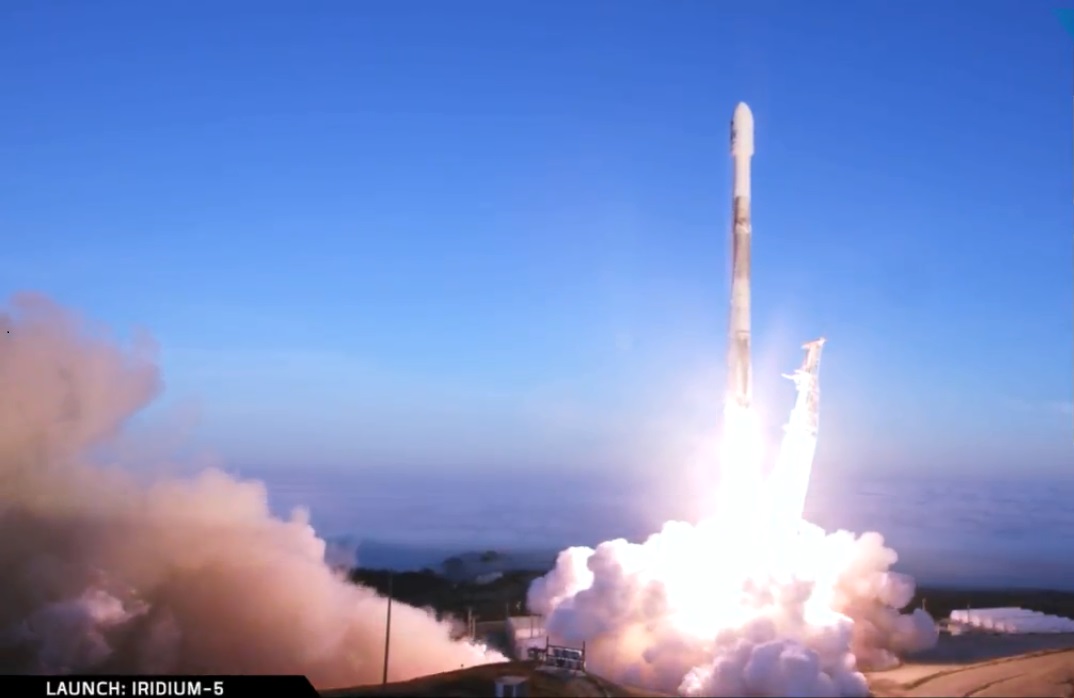Liftoff! Used SpaceX Rocket Launches 10 Iridium Satellites into Orbit
A used SpaceX Falcon 9 rocket launched 10 new communications satellites into orbit from California's Vandenberg Air Force Base today (March 30) in a morning liftoff that also marked an anniversary for reusable rockets.
The Falcon 9 rocket, which first flew in October 2017, launched the fifth set of Iridium Next satellites for Iridium Communications at 10:13 a.m. EDT (1413 GMT) — exactly one year to the day after SpaceX's first used Falcon 9 rocket launch and landing. Since then, SpaceX has commonly landed the first stage of its two-stage Falcon 9 rockets and reused them on later flights.
In fact, the booster that launched today's Iridium-5 mission also launched 10 other Iridium Next satellites on Oct. 9 during SpaceX's Iridium-3 mission. And last December, Iridium became the first SpaceX customer to launch a mission on a rocket it used before when the Iridium-4 mission launched with the same booster SpaceX used to launch 10 other satellites on its Iridium-2 flight in June 2017.
"Today, this is our fifth launch for the Iridium constellation, using only three rockets," SpaceX materials engineer Michael Hammersley said during live commentary.

If that sounds like a lot of launches for Iridium to you, you're not wrong. Iridium has tapped SpaceX to launch 75 Iridium Next satellites to build up its communications constellation in orbit. To do that, Iridium has bought eight Falcon 9 launches for a total of $536 million.
In one departure from typical SpaceX launches, the company cut the live video feed from the Falcon 9 second stage about 9 minutes into the flight.
"Due to some restrictions from the National Oceanic and Atmospheric Administration, NOAA for short, SpaceX will be intentionally ending live video coverage from the second stage just prior to engine shutdown," Hammersley said. "We're working with NOAA to address these restrictions in order to hopefully be able to bring you live views from orbit in the future." [Related: What's the Deal with SpaceX, NOAA and Live Launch Video]
Get the Space.com Newsletter
Breaking space news, the latest updates on rocket launches, skywatching events and more!
Those restrictions apparently have to do with SpaceX's rocket camera video qualifying as a remote sensing system for Earth observation, which may require a NOAA license. NOAA officials said via Twitter that they are looking into the situation.
The 10 Iridium Next satellites were scheduled to be deployed about 42 minutes after reaching orbit, bringing Iridium's constellation up to 50 satellites. SpaceX launched the first 10 Iridium Next satellites in January 2017, with three more missions following in June, October and December of that year. The entire constellation of Iridium Next satellites (which includes 66 operational satellites and nine in-orbit spares) should be in orbit by mid-2018 if SpaceX's current launch pace holds.
The Hawthorne, California-based SpaceX has regularly launched, landed and re-flown Falcon 9 rockets as part of the company's reusable-rocket program aimed at lowering the cost of spaceflight. However, SpaceX did not attempt to land the Iridium-5 booster on its offshore drone ship Just Read the Instructions. Instead, the booster was expected to fly a landing approach over the open sea in the Pacific Ocean, and then splash down.
Hammersley said SpaceX did send out its recovery boat Mr. Steven, which is equipped with a giant net held up by huge steel arms, to try to catch half of the Falcon 9 rocket's payload fairing, the protective nose cone that covers satellite payloads during launch. SpaceX CEO Elon Musk has called the boat a "catcher's mitt" in boat form.
Musk reported that the payload fairing capture attempt was unsuccessful. The fairing's GPS-guided parafoil twisted during descent, causing the fairing to hit the ocean at high speed. Drop tests from a helicopter could occur in the next few weeks to help solve the issue, Musk wrote on Twitter.
SpaceX's first attempt to catch a Falcon 9 fairing just missed earlier this year. The company is hoping to recover payload fairings, which cost up to $6 million each, to lower the cost of its launches even more.
Today's Iridium-5 mission is not the only one on SpaceX's mind this week. Another used Falcon 9 rocket is scheduled to launch a Dragon cargo ship, which has also flown in space before, on Monday (April 2) from Cape Canaveral Air Force Station in Florida. That Dragon spacecraft will deliver fresh food, equipment and other supplies to the International Space Station once it arrives Wednesday (April 4).
Editor's note: This story has been updated to include more details on the video blackout during today's launch, and the results of SpaceX's attempt to catch the Falcon 9 payload fairing.
Email Tariq Malik at tmalik@space.com or follow him @tariqjmalik. Follow us @Spacedotcom, Facebook and Google+. Original article on Space.com.
Join our Space Forums to keep talking space on the latest missions, night sky and more! And if you have a news tip, correction or comment, let us know at: community@space.com.

Tariq is the Editor-in-Chief of Space.com and joined the team in 2001, first as an intern and staff writer, and later as an editor. He covers human spaceflight, exploration and space science, as well as skywatching and entertainment. He became Space.com's Managing Editor in 2009 and Editor-in-Chief in 2019. Before joining Space.com, Tariq was a staff reporter for The Los Angeles Times covering education and city beats in La Habra, Fullerton and Huntington Beach. In October 2022, Tariq received the Harry Kolcum Award for excellence in space reporting from the National Space Club Florida Committee. He is also an Eagle Scout (yes, he has the Space Exploration merit badge) and went to Space Camp four times as a kid and a fifth time as an adult. He has journalism degrees from the University of Southern California and New York University. You can find Tariq at Space.com and as the co-host to the This Week In Space podcast with space historian Rod Pyle on the TWiT network. To see his latest project, you can follow Tariq on Twitter @tariqjmalik.









